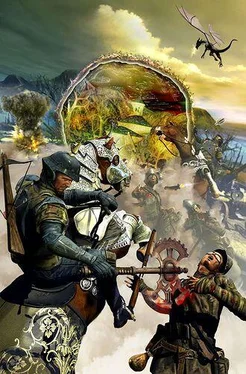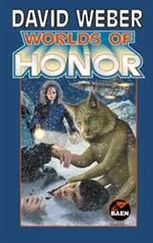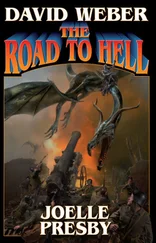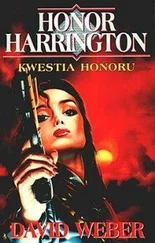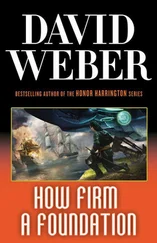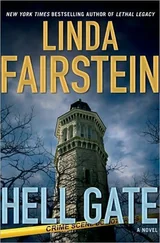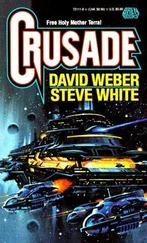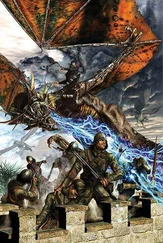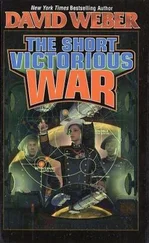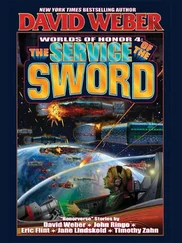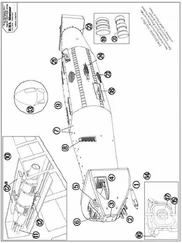Jasak had no idea what mysterious properties these tubular weapons operated upon. Nor could he figure out what many of the parts did, but he recognized precision engineering when he saw it.
A dragoon arbalest, like the one Otwal Threbuch favored, used a ten-round magazine and a spell-enhanced cocking lever. The augmented lever required a force of no more than twenty pounds to operate, and an arbalestier could fire all ten rounds as quickly as he could work the lever. It had almost as much punch?albeit over a shorter range?as the standard, single-shot infantry weapon, and a vastly higher rate of fire, but no man ever born was strong enough to throw the cocking lever once the enhancing spell was exhausted. Infantry weapons were much heavier, as well as bigger, and used a carefully designed mechanical advantage. They might be difficult to span without enhancement, but it could be done?which could be a decided advantage when the magic ran out?and they were considerably longer ranged.
The workmanship which went into a dragoon arbalest had always impressed Jasak, but the workmanship of whoever had built these weapons matched it, at the very least. Still, he would have liked to know what all of that craftsmanship did. Even the parts whose basic function he suspected he could guess raised far more questions than they answered.
For example, the weapon he was examining at the moment was about forty-two inches long, over all. The tube through which those small, deadly projectiles passed was shorter?only about twenty-four inches long?and it carried what he recognized as at least a distant cousin of the ring-and-post battle sights mounted on an arbalest. But the rear sight on this weapon was set in an odd metal block mounted on a sturdy, rectangular steel frame about one inch across. The sides of the rectangle were no more than a thirty-second of an inch across, as nearly as his pocket rule could measure, and it frame could either lie flat or be flipped up into a vertical position.
When it was flipped into the upright position, a second rear sight, set into the same metal block as the first, but at right angles, rotated up for the shooter's use. But the supporting steel rectangle was notched, and etched with tiny lines with some sort of symbols which (he suspected) were probably numbers, and the sight could be slid up and down the frame, locked into place at any one of those tiny, engraved lines by a spring-loaded catch that engaged in the side's notches.
Jasak had spent enough time on the arbalest range to know all about elevating his point of aim to allow for the drop in the bolt's trajectory at longer ranges. Unless he missed his guess, that was the function of this weapon's peculiar rear sight, as well. If so, it was an ingenious device, which was simultaneously simple in concept and very sophisticated in execution. But what frightened him about it was how high the rear sight could be set and the degree of elevation that would impose. Without a better idea of the projectiles' velocity and trajectory, he couldn't be certain, of course, but judging from the damage they'd inflicted, this weapon's projectiles must move at truly terrifying velocities. Which, in turn, suggested they would have a much flatter trajectory.
Which, assuming the sophisticated, intelligent people who'd designed and built it hadn't been in the habit of providing sights to shoot beyond the weapon's effective range, suggested that it must be capable of accurate shooting at ranges far in excess of any arbalest he'd ever seen.
There was a long metal oval underneath the weapon. It was obviously made to go up and down, and he suspected that it had to be something like the cocking lever on Threbuch's dragoon arbalest. In any case, he had absolutely no intention of fiddling with it until they were in more secure territory, away from potential enemy contact. And when he let the very tip of his finger touch the curved metal spur jutting down into the guarded space created by a curve in the metal oval, his fingertips jerked back of their own volition. That startled him, although only for a moment. Obviously, that curved spur was the weapon's trigger?it even looked like the trigger on one of his own men's arbalest's?and his meager Gift was warning him that it was more dangerous than the cocking lever (if that is what it was).
The metal tube itself was made from high-grade steel, and when he peered?very cautiously?into it, adjusting it to get a little firelight into the hollow bore, he saw what looked like spiraling grooves cut into the metal. Interesting. The Arcanan Army understood the principal of spinning a crossbow bolt in flight to give it greater stability and accuracy. He couldn't quite imagine how it might work, but was it possible that those spiraling grooves could do the same thing to the deadly little leaden projectiles this thing threw?
He put that question aside and turned his attention to the snug wooden sleeve into which the tube had been fitted. It was held in place with three wide bands of metal that weren't steel. They looked like bronze, perhaps. The wood itself continued behind the tube to form a buttplate?again, not unlike an arbalest's?so a full third of the weapon's length was solid wood.
The long, tapering section of wood, narrowest near the tube, widest at the weapon's base, had been beautifully checkered by some intricate cutting process. It was the only decoration on the weapon, and it was obviously as much a practical design feature as pure decoration. As Jasak handled it, he realized that the checkering would serve exactly the same function as the fishscale pattern cut into the forestocks of arbalests, making them easier to grip in wet weather.
Other items ranged from the obvious?camp shovels, hatchets, backpacks?to the completely mysterious, and he gradually realized that what wasn't there was as interesting as what was. Although Jasak searched diligently, he found no trace of maps or charts anywhere in their gear. He found notebooks, with detailed botanical drawings and startlingly accurate sketches of wildlife, but no trace of a single chart.
The implication was clear; they'd realized?or, feared, at least?that their position was hopeless, so they'd destroyed the evidence of where they'd been. If they were, indeed, a civilian version of Jasak's Scouts, working to survey new universes and map new portals, they would have carried detailed charts that showed the route back to their home universe. From a military standpoint, losing those maps was a major disaster for Arcana. From a political standpoint …
Jasak thought about the reaction news of this battle was bound to trigger?particularly in places like rabidly xenophobic Mythal, whose politicians trusted no one, not even themselves. Especially not themselves. As he thought about them and their probable response, Jasak Olderhan was abruptly glad these people had destroyed their maps, even as the Andaran officer in him recoiled from such blatant heresy.
He told the Andaran officer to shut up, and that shocked him, too. Yet he couldn't help it, for a shiver had caught him squarely between the shoulder blades, an odd prescience quivering through him like a warning of bloodshed and disaster.
Than a log snapped in the fire, jolting him out of his eerie reverie, and the uncanny shiver passed, leaving him merely chilled in the night air. He rubbed the prickled hairs on the back of his neck, trying to smooth them down again, and his glance was caught by a small, flat circular object lying wedged into the box of jumbled gear at his feet. He picked it up, and was surprised by its weight. The object was made of metal, rolled or cast to form a strong metal casing. After fiddling with it for a couple of moments, he determined that the top section was a lid that unscrewed. He removed it … and stared.
Inside were two … machines, he decided, not knowing what else to call them. In the lid section, there was a glass cover that sealed off a thin metallic needle, flat and dark against a white background. Tiny hatchmarks were spaced evenly around the circular "face" with neat, almost military precision. More alien symbols?letters or numbers, he was certain?marked off eight points around the perimeter.
Читать дальше
